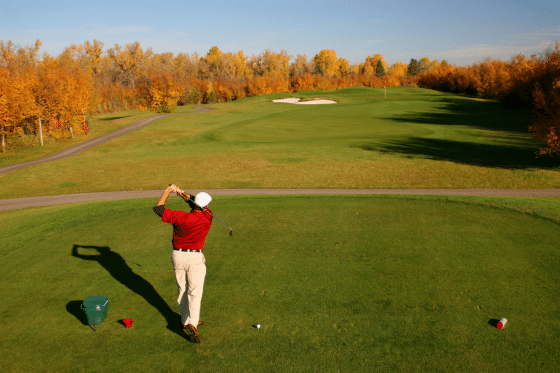As temperatures drop and the fairways turn frosty, many golfers pack their clubs away until spring. But here’s the secret: winter isn’t the time to stop thinking about your golf game — it’s the time to prepare for your best season yet.
The colder months offer an ideal window to improve your flexibility, strengthen your swing mechanics, and protect your body from the common injuries that hold players back year after year. With a little guidance, you can stay sharp, mobile, and confident — ready to hit the ground running when the first tee times of spring roll around.
Why Golf Feels Tougher in Cold Weather
When the temperature dips, your muscles and joints naturally tighten. Circulation slows, and your body doesn’t move as freely. Even your golf ball reacts differently — it compresses less and travels shorter distances.
As a result, many golfers instinctively swing harder to compensate, placing extra stress on the back, shoulders, and elbows. Combine that with a lack of warm-up or mobility work, and you have the perfect recipe for strain, stiffness, or even injury.
This isn’t about getting older — it’s about physics and physiology. Cold weather simply makes the body less responsive. The good news? With the right approach, you can keep your swing smooth, strong, and pain-free all season long.
Warm Up Like a Pro
A quick stretch before hitting the first ball can make all the difference. Your warm-up doesn’t need to be long or complicated — just effective.
Try this simple routine before heading to the range or course:
- Torso Rotations: Stand tall and gently rotate your upper body side to side, keeping your hips stable.
- Hip Circles: Loosen up the hips and lower back — key areas for generating rotation and power.
- Shoulder Rolls and Arm Swings: Warm up your upper back and shoulders to prepare for a fluid swing.
- Gentle Practice Swings: Start slow, focusing on rhythm and balance before building up to full speed.
Even five minutes of movement will help increase blood flow, improve joint mobility, and reduce stiffness — helping you maintain consistency through your round.
Strength and Stability: The Foundation of Your Swing
Cold-weather golf is as much about preparation as it is about performance. When the weather keeps you indoors, use that time to work on strength and stability — especially through the core, hips, and glutes.
These muscle groups are the engine of your swing. When they’re weak, your body compensates elsewhere — often leading to back pain or shoulder discomfort.
A few key exercises to focus on include:
- Bridges or Glute Raises to build hip power and stability.
- Planks and Side Planks to support your spine during rotation.
- Rotational Resistance Band Work to mimic the movement of your swing while strengthening the torso.
Working on these foundations through winter can dramatically improve your balance and control once you’re back on the course.
Mobility Matters: Keep Your Body Moving
Mobility — not just flexibility — is what allows your swing to stay fluid and powerful. Cold weather can limit range of motion, especially in the hips and upper spine, making your swing shorter and less efficient.
Simple daily habits can help keep your mobility intact:
- Stretch after a shower when muscles are warm.
- Spend a few minutes each morning doing gentle spinal twists.
- Use a foam roller to release tightness in your quads, glutes, and upper back.
Remember, mobility isn’t about touching your toes — it’s about maintaining smooth, controlled movement in the joints that matter most to your game.
Indoor Drills to Sharpen Your Technique
Just because the weather’s cold doesn’t mean your golf swing should hibernate. There are plenty of ways to stay connected to your game indoors:
- Mirror Practice: Work on posture and alignment. Use a mirror to check your shoulder tilt and weight distribution.
- Slow-Motion Swings: Focus on rhythm and transition instead of speed.
- Putting and Chipping Drills: A carpet or putting mat can keep your short game sharp through winter.
By keeping your movements consistent through the off-season, you’ll return to the course in spring with more control and confidence.
Don’t Ignore Pain or Discomfort
Cold weather often highlights underlying issues — that stiff shoulder, that tight lower back, that hip that doesn’t quite rotate like it used to. These are your body’s warning signs, not just seasonal inconveniences.
A physical therapist can help identify movement restrictions, muscle imbalances, or early signs of strain before they develop into a bigger problem. By addressing these in the off-season, you set yourself up for a pain-free return when golf season resumes.
Get Ahead of the Game
Think of winter as your opportunity to rebuild the foundation of your game. While others are waiting for the sunshine, you’re putting in the quiet work that leads to smoother swings, stronger drives, and better endurance through 18 holes.
Consistency, not intensity, is what matters most. Move regularly, warm up properly, and take care of the muscles that power your game. When the season starts, your body will thank you — and your scorecard might too.
Ready to keep your golf swing strong through winter?
Book a session with Paul Hendricks Physiotherapy today and learn how to stay mobile, prevent injury, and prepare your body for your best season yet.


